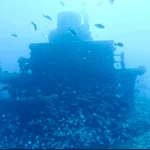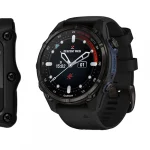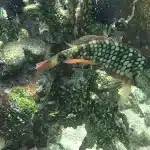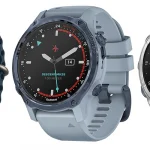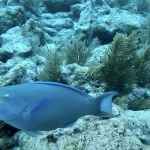Exploring the Depths: The USNS Vandenberg
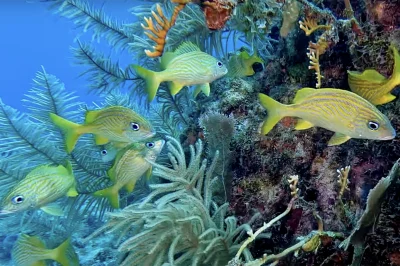
Table of Contents
- Exploring the Depths: The USNS Vandenberg
- The Mystery of Ten-Fathom Bar: Navigating Deep Reef Walls
- Cayman Salvage Master: Mastering the Art of Wreck Diving
- Managing Key West’s Dynamic Dive Conditions
- Certifications Tailored for Key West’s Diving Scene
- The Coral Kingdom: Protecting Key West’s Underwater Ecosystem
- Advanced Night Dive Adventures in Key West
- Future Trends in Key West Diving: A Look Ahead
Introduction
For the seasoned scuba diving enthusiast, Key West offers a range of exciting and challenging adventures beneath the waves. This expert guide dives into the top experiences that make a visit to Key West a bucket-list priority for advanced divers.
Exploring the Depths: The USNS Vandenberg
Ten-Fathom Bar, situated approximately 11 miles southwest of Key West, provides a captivating and challenging environment for scuba divers. This dive site is often associated with the broader Ten-Fathom Ledge, known for its dramatic underwater landscapes that include sharp drop-offs and vibrant coral formations. Divers should note the precise coordinates of Ten-Fathom Bar at 24’26.402N 081’52.669W, marking it near the Western Sambo Reef.
Depth and Features
The depth at Ten-Fathom Bar varies significantly, ranging from the shallow regions of 25 feet to a striking drop-off that plunges down to 130 feet. The average dive depth is about 40 feet, making it an exhilarating spot for more experienced divers. Highlights of the site include:
- Underwater Wall: A dramatic vertical drop from 50 feet down to 130 feet, creating stunning visual contrasts and habitats.
- Coral Caves and Overhangs: These formations not only add to the beauty but also provide shelter for various marine species.
- All-Alone Wreck: This 75-foot tugboat wreck, submerged at 90 feet, attracts an array of marine life, including barracudas and groupers, making it a focal point for divers.
Currents and Visibility
Diving conditions at Ten-Fathom Bar can be influenced by strong currents from the Gulf Stream. Divers are advised to have solid buoyancy control to navigate these waters effectively. Typically, visibility ranges from 50 to 100 feet, enhanced by the clear waters brought in by the Gulf Stream, making for excellent underwater photography and exploration.
Marine Life
The biodiversity at Ten-Fathom Bar is remarkable, featuring a variety of marine species:
- Large Predators: Sightings of barracudas, tarpon, and even sharks are common.
- Reef Life: Divers can expect to observe groupers, snook, spiny lobsters, and a plethora of colourful tropical fish in their natural habitat.
Dive Level and Best Time
This dive site is considered suitable for intermediate to advanced divers due to the depth and current conditions. The ideal time for diving at Ten-Fathom Bar is from June to November, when water temperatures are warmest and visibility is at its peak.
Practical Considerations
As Ten-Fathom Bar is not marked by a buoy, employing a local dive charter is highly recommended for safe navigation and exploration of this stunning underwater environment.
The Mystery of Ten-Fathom Bar: Navigating Deep Reef Walls
Technical Dive Challenges
Advanced divers in Key West often face a variety of challenges that test their skills in technical diving and site management. This region offers some of the most exciting diving experiences, ranging from deep wreck dives to vibrant reefs. Here are some of the key challenges:
- Deeper Site Exploration: Key West features dives reaching depths of 130–140 feet, including sites like the Ten-Fathom Bar mini-wall and the iconic Vandenberg wreck. Such depths demand precise depth management, gas calculations, and controlled ascents to ensure safety.
- Low-Visibility Navigation: Specialty dives, especially those focusing on underwater navigation, can involve low visibility conditions. Divers must hone their compass skills and ability to navigate using natural features.
- Current and Wreck Management: The Vandenberg wreck, a popular dive site, necessitates expert buoyancy control and spatial awareness to navigate the various structures and avoid hazards.
Site Selection and Conditions
Choosing the right dive site is crucial for an enjoyable and safe experience:
- Diverse Environments: Key West provides a range of dive settings, from shallow reefs to deep wall dives and artificial reefs, requiring divers to adapt to changing currents and marine life.
- Avoiding Over-Trafficked Areas: Some sites, such as Sand Key, can become crowded, potentially diminishing the dive experience. Advanced divers often seek less frequented locations or carefully plan their dive times to avoid peak periods.
Safety and Training Considerations
Keeping safety at the forefront of diving activities is essential:
- Planning Complexity: Advanced divers must be thorough in their dive planning, maintaining detailed logbooks, performing gas calculations, and preparing contingency plans for emergencies.
- Adhering to Certification Limits: Understanding and following certification limits, such as those set by the PADI Advanced Open Water Diver course, helps prevent accidents, especially in deeper waters.
- Buddy System Dependency: Utilizing the buddy system is critical for monitoring air supplies, executing decompression stops, and navigating back to safety.
Training Opportunities
Key West offers robust training programs tailored to advanced divers:
- Mandatory Dives: The PADI Advanced Open Water Diver course includes essential dives focusing on deep diving, navigation, and buoyancy control.
- Elective Specialties: Divers can select from a variety of electives such as wreck diving, peak performance buoyancy, or naturalist dives to customize their training experience.
For seasoned divers, Key West presents a blend of foundational training and real-world challenges. Careful planning and adherence to safety protocols are paramount when navigating these exciting underwater environments.
Cayman Salvage Master: Mastering the Art of Wreck Diving
Managing Key West’s Dynamic Dive Conditions
When diving in Key West, understanding the variable conditions can significantly enhance the experience. The interplay of weather, currents, and boat traffic creates a complex environment for divers.
Weather
Key West’s weather impacts diving conditions in multiple ways. Surface temperatures soar in mid-summer, often reaching 85–86°F during July and August, and remaining warm into September and October. During this period, the seas can be relatively calm, with typical wave heights of 1–3 feet, although isolated showers and thunderstorms may occur, necessitating careful trip planning. As divers observe these conditions, they must also monitor wind speeds and UV exposure, which can affect overall visibility and comfort during dives.
Currents
While Gulf Stream currents are not uniformly detailed in reports, divers should be prepared for variations in water flow, particularly around deeper dive sites and reefs such as the Vandenberg wreck. Understanding these currents is crucial, as they can change quickly with varying sea conditions. Divers should continually assess environmental factors to ensure safety and optimal diving conditions.
Boat Traffic
Boat traffic in Key West significantly escalates during peak seasons, particularly during the lobster mini-season in late July and the full lobster season throughout August. This heightened activity can lead to crowded conditions near popular dive sites. Awareness of local events, such as fishing tournaments and festivals, can also contribute to congested waters, making it essential for divers to plan trips with regard to these factors.
Challenges
- Visibility Fluctuations: Visibility can vary considerably due to shifting sea conditions and winds, though good conditions can allow for visibility ranges of 30 to 50 feet.
- Weather Volatility: Summer storms can temporarily disrupt diving, but conditions usually stabilize quickly.
- Seasonal Crowding: Divers should prioritize timing, especially during high seasons to avoid congestion at dive sites.
For real-time updates and conditions, consulting reputable dive centres or NOAA marine forecasts is highly recommended to stay informed and prepared for a safe diving experience.
Managing Key West’s Dynamic Dive Conditions
Specialized Certifications Tailored for Key West’s Diving Scene
To engage in wreck diving in Key West, particularly for deeper reefs or navigating complex sites like the USS Vandenberg, specific certifications are essential:
Key Certifications
- Adventure Diver or Higher
The foundational requirement for the Wreck Diver Specialty course is the PADI Adventure Diver certification (or equivalent). This ensures divers have basic specialty training, such as underwater navigation or deep diving. - Wreck Diver Specialty
This course teaches:- Safe entry and exit techniques for wrecks
- Hazard awareness (e.g., entanglement risks)
- Proper buoyancy and equipment management
Dive operators like Silent World Dive Center offer this program in nearby Key Largo, although similar courses can likely be found in Key West itself.
- Advanced Open Water (AOW) or Deep Dive Specialty
Required specifically for accessing the Vandenberg wreck due to its depth (~140 ft). The AOW certification covers:- Deep diving (beyond 60 ft)
- Advanced navigation techniques
- Night diving
Skill Summary
| Certification | Key Skills Gained | Wreck Diving Use Case |
|---|---|---|
| Adventure Diver | Specialty-specific training | Prerequisite for Wreck Diver |
| Wreck Diver Specialty | Wreck penetration, hazard assessment | Direct wreck exploration |
| AOW/Deep Dive | Depth management, navigation | Accessing deeper wrecks like Vandenberg |
Providers such as Finz Dive Center and Dive Key West emphasize the importance of these certifications for safe and enjoyable wreck diving excursions.
Dive Computers
- Diving Computers for Female Divers
- Wreck Diving Computers
- Beginner Diving Computers
- Low-Light Diving Computers
- Technical Diving Computers
- Freediving Computers
- Underwater Photography Diving Computers
- Cold-Water Diving Computers
- Travel-Friendly Diving Computers
- Multi-sport Diving Computers
- Budget-Friendly Diving Computers
- Advanced Recreational Diving Computers
- Smartwatch-Compatible Diving Computers
- Child-Friendly Diving Computers
- Military or Professional Diving Computers
Certifications Tailored for Key West’s Diving Scene
Advanced Dive Experiences in Key West
Key West offers specialized diving opportunities tailored to intermediate and advanced divers, with a mix of technical challenges, deep-water exploration, and unique ecosystems.
Deep-Water Wreck Diving
Vandenberg Wreck:
- Located 6 miles southeast of Key West, this 140-foot-deep wreck provides versatile diving for mixed groups. Advanced divers can explore the lower structures independently with a dive computer, navigating complex passageways and deep sections.
- Hosted by PADI 5-star centers, dives here emphasize safety and site-specific logistics managed by experienced guides.
Ten-Fathom Bar Wall Dive:
- A rare mini-wall dive in Florida, this site drops from 30 to 130 feet, offering dramatic underwater landscapes. It’s ideal for advanced open-water training or deep-diving certifications.
Reef and Technical Dives
Marquesas Reef Line:
- Features coral caves and deeper reef structures in the Florida Keys National Marine Sanctuary. This site provides opportunities to refine navigation skills in low-visibility conditions, often incorporated into advanced certifications.
Advanced Training and Certifications
PADI Advanced Open Water Diver Certification:
- Covers specialty dives such as deeper diving (60–130 feet), underwater navigation, and peak performance buoyancy. Divers can combine certifications with wreck or reef dives.
- Centers like Lost Reef Adventures offer checkout dives for completing certifications in tropical waters.
Dive Operators for Advanced Divers
- Key West Scuba Diving: Focuses on wreck and reef dives with speedy booking and experienced guides.
- Lost Reef Adventures: Provides structured courses, checkout dives, and two-tank trips to explore multiple sites.
Logistics and Planning
- Two-tank afternoon dives allow exploring distinct sites, such as combining a wreck dive with a reef dive.
- Professional operators select sites based on visibility and conditions, ensuring optimised diving experiences.
These options cater to divers seeking technical challenges, specialized training, or immersive exploration of Key West’s iconic underwater environments.
The Coral Kingdom: Protecting Key West’s Underwater Ecosystem
Preparing for Advanced Night Diving in Key West
To prepare effectively for advanced night diving in Key West, focus on strategic planning, visibility management, and leveraging local expertise. Here’s a structured approach:
Pre-Dive Preparation
- Conduct Daylight Reconnaissance:
Dive the site during daylight to map underwater features (e.g., reef structures, current patterns) and establish spatial awareness. This reduces disorientation risks at night, particularly in low-visibility environments.
- Optimise Gear Adjustments:
- Buoyancy Control: Test wetsuits, hoods, or added layers during daylight dives to adjust weights, avoiding last-minute adjustments underwater.
- Lighting: Use rechargeable primary lights with focused beams and carry a backup light. Attach a strobe or glow stick to your BCD for visibility.
- Engage Local Dive Shops:
Consult operators like Horizon Dive Center or Finz Dive Center for insights on shallow reefs (e.g., bay areas) ideal for night dives, which offer better navigation and longer bottom times.
Visibility Management
- Dive Timing: Start at dusk to witness the transition of marine life (e.g., nocturnal predators emerging) while maintaining residual light for initial orientation.
- Communicate with Light Signals: Establish prearranged signals (e.g., circular motions for “OK,” horizontal lines for alerts) to avoid confusion in darkness.
Marine Life Observation
- Target Shallow Reefs: Focus on areas like grass beds or shallow coral reefs, where visibility is naturally better. These habitats host nocturnal creatures (e.g., moray eels, crabs) and provide stable platforms for observing activity cycles.
Post-Dive Protocol
- Check Instruments: Regularly monitor depth and air supply, as visual cues are limited.
- Use Backup Lighting: Ensure all dive partners carry independent light sources to prevent reliance on a single light.
By combining site familiarity, strategic equipment use, and localized expertise, you can enhance safety and maximise encounters with Key West’s unique nocturnal ecosystem.
Advanced Night Dive Adventures in Key West
Key West Scuba Diving Advanced Experiences in 2025
The Florida Keys, particularly Key West, offer diverse advanced diving opportunities, ideal for certified divers seeking specialized training and challenging environments. Here’s a breakdown of key options and experiences:
PADI Advanced Open Water Diver Certification
This course builds on Open Water training with five specialty dives, including:
- Deep Diving: Descend to depths of 60–130 feet at sites like the Ten-Fathom Bar (featuring a mini-wall that drops from 30 to 130 feet) or the USNS General Hoyt S. Vandenberg wreck (140 feet deep).
- Underwater Navigation: Practice compass use in low-visibility conditions.
- Optional Specialties: Choose three from peak performance buoyancy, underwater naturalist, or boat diver.
Key West’s proximity to reefs like the Marquesas Reef Line (with its coral caves) and access to the Atlantic Ocean and Gulf of Mexico provide varied environments for skill development.
Advanced Dive Sites
Key West features unique sites catering to experienced divers:
- Vandenberg Wreck: A 520-foot-long artificial reef at 140 feet, teeming with marine life.
- Ten-Fathom Bar: Offers a vertical wall dive from 30 to 130 feet—ideal for deep-diving training.
- Marquesas Reef Line: Known for its coral formations and caves, suitable for navigation and naturalist dives.
Post-Certification Diving Opportunities
Experienced divers can explore multiple sites via 2-tank trips, targeting varied ecosystems such as:
- Living Coral Reefs: Dive the Florida Keys National Marine Sanctuary’s third-largest barrier reef.
- Wrecks: Explore smaller sunken vessels or aircraft.
Operators like Key West Scuba Diving and Cool Key West provide guided trips on custom dive boats, often combined with refresher courses or advanced certifications. For divers returning after a break, refresher courses combine pool skills with reef dives to rebuild confidence before progressing to advanced training.
Future Trends in Key West Diving: A Look Ahead
Advanced Scuba Diving Experiences in Key West
Key West is renowned for its diverse aquatic ecosystems, offering a range of experiences that cater to advanced divers seeking to push their limits.
Wreck Diving
Among the most notable wreck dives is the USNS General Hoyt S. Vandenberg, a 520-foot-long artificial reef situated at a depth of 140 feet, just six miles offshore. This massive wreck attracts advanced divers due to its complex structure and the variety of marine life that has made it their home. The Vandenberg provides a captivating dive experience, with opportunities to explore the ship’s cargo holds, deck structures, and the surrounding reef ecosystem. It’s a perfect spot for divers looking to challenge themselves while enjoying the thrill of wreck exploration.
Deep Reef & Wall Dives
For those interested in deep diving, Ten-Fathom Bar offers unique mini-wall dive experiences where the seafloor drops dramatically from 30 feet to 130 feet. This dive site provides challenging conditions, ideal for skill enhancement and environmental exploration. Additionally, the Marquesas Reef Line within the Florida Keys National Marine Sanctuary features intricate coral structures and deeper reef ecosystems. Divers can test advanced navigation techniques amidst the stunning underwater landscapes.
Technical Training Opportunities
Advanced divers may consider the PADI Advanced Open Water Diver certification, a structured program designed to refine diving skills. This certification encompasses:
- Deeper Diving: dives ranging from 60 to 130 feet
- Underwater Navigation: learning to navigate in low-visibility conditions
- Specialty Dives: such as peak performance buoyancy and underwater naturalist
Key West’s diverse dive sites serve as the perfect backdrop for these essential training experiences.
Guided Excursions
Reputable dive operators like Lost Reef Adventures and Key West Scuba Diving offer specialized excursions for experienced divers, ensuring access to premier wreck and reef sites. These professionals provide essential logistical support and expert guidance, enhancing the overall experience and safety during deep dives. Tailored trips allow divers to maximise their time underwater, focusing on skill development and exploration.
Sources
- Dive in Key West – Ten Fathom Bar
- Dive Buddy – Ten Fathom Bar
- Key West Dive Center – Ten Fathom Ledge
- Key West Dive Center – All Alone on Ten Fathom Ledge
- Florida Scuba Diving – Key West Dive Guide
- News Channel Nebraska – Why You Should Book an Advanced Scuba Diving Charter in Key West
- Key West Scuba Diving – PADI Advanced Open Water Diver Certification
- ScubaBoard – Key West Ops to Avoid

